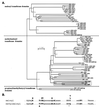Organization of the biosynthetic gene cluster for the polyketide anthelmintic macrolide avermectin in Streptomyces avermitilis
- PMID: 10449723
- PMCID: PMC22239
- DOI: 10.1073/pnas.96.17.9509
Organization of the biosynthetic gene cluster for the polyketide anthelmintic macrolide avermectin in Streptomyces avermitilis
Abstract
Analysis of the gene cluster from Streptomyces avermitilis that governs the biosynthesis of the polyketide anthelmintic avermectin revealed that it contains four large ORFs encoding giant multifunctional polypeptides of the avermectin polyketide synthase (AVES 1, AVES 2, AVES 3, and AVES 4). These clustered polyketide synthase genes responsible for avermectin biosynthesis together encode 12 homologous sets of enzyme activities (modules), each catalyzing a specific round of polyketide chain elongation. The clustered genes encoding polyketide synthase are organized as two sets of six modular repeats, aveA1-aveA2 and aveA3-aveA4, which are convergently transcribed. The total of 55 constituent active sites makes this the most complex multifunctional enzyme system identified to date. The sequenced DNA region contains 14 additional ORFs, some of which encode polypeptides governing other key steps in avermectin biosynthesis. Between the two sets of polyketide synthase genes lie two genes involved in postpolyketide modification, one of which encodes cynthochrome P450 hydroxylase that probably catalyzes furan ring formation at C6 to C8a. Immediately right of the large polyketide synthase genes is a set of genes involved in oleandrose biosynthesis and its transglycosylation to polyketide-derived aglycons. This cluster includes nine genes, but one is not functional in the biosynthesis of avermectin. On the left side of polyketide synthase genes, two ORFs encoding methyltransferase and nonpolyketide synthase ketoreductase involved in postpolyketide modification are located to the left of the polyketide synthase genes, and an adjacent gene encodes a regulatory function that may be involved in activation of the transcription of avermectin biosynthetic genes.
Figures



References
Publication types
MeSH terms
Substances
Associated data
- Actions
- Actions
- Actions
LinkOut - more resources
Full Text Sources
Other Literature Sources
Medical
Miscellaneous

